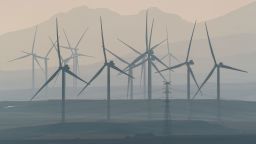Planet-warming methane pollution from the US oil and gas industry was 70% higher than the Environmental Protection Agency’s own estimates between 2010 and 2019, scientists reported Monday.
The new study, published in the Proceedings of the National Academy of Sciences, suggests the federal government’s current system for detecting methane leaks from fossil fuel pipes, wells and compressors is inadequate. Several recent studies have shown similar results, and scientists now say the EPA needs to leverage new technology to get a fuller picture of how much of this potent greenhouse gas is escaping into the atmosphere and hold companies accountable for the leaks.
Methane, the main component of natural gas and a byproduct of fossil fuel drilling, has more than 80 times the warming power of carbon dioxide in the first two decades it’s in the atmosphere. The oil and gas industry is the main source of global methane emissions, according to the International Energy Agency. Levels have risen precipitously in recent years, and scientists are looking at the gas as a target to cut climate emissions quickly because it has such a powerful warming effect.
While researchers used data from satellite instruments to paint a picture of methane leaks across the US, oil and gas operators and the EPA often rely on engineering models and hand-held infrared equipment to track leaks, which experts say is inadequate.
“This has been known for a while, at least in the atmospheric science community,” said Daniel Jacob, one of the study’s lead authors and a professor of atmospheric chemistry and environmental engineering at Harvard University. “When we observe methane in the air, we find concentrations much higher than one would expect from the EPA inventories.”
In a statement, an EPA spokesperson noted that another recent study found that 2019 levels were on par with the agency’s estimates for that year.
“The EPA continues to work through its stakeholder process to review new data from [its] Greenhouse Gas Reporting Program and research studies to assess how emissions estimates can be improved,” the spokesperson said.
Experts told CNN Monday’s study points to the need for the agency to adopt better monitoring practices, as technology has advanced by leaps and bounds in the last few years. New satellite instruments can monitor methane leaks with high accuracy from space, and there are emerging remote-sensing technologies that can help pinpoint leaks coming from specific locations.
“There really have been transformational advances in remote sensing technology for methane over the last decade and the last three to four years,” Riley Duren, CEO at nonprofit Carbon Mapper and a University of Arizona researcher, told CNN. “That reporting program doesn’t require operators to go out and fly airplanes. It’s largely based on models and standard emissions factors.”
A new way to find leaks
There’s no question the EPA is monitoring methane leaks from oil and gas operations, experts said. The problem is the scale of monitoring is too small and infrequent.
Existing EPA regulations require oil and gas companies to do quarterly inspections using hand-held infrared cameras and sensors to look for leaks coming from wells and equipment, and much of the rest is accounted for with engineering models.
The problem is this technique tends to miss a lot of leaked methane, experts said.
“A leak that goes on for some days and then gets fixed, or some operator venting gas at a particular time of day – if you’re just cruising around and trying to observe hotspots, you might miss them,” Jacob said.
Jacob and other atmospheric scientists say there should be more monitoring of methane from the air, which can catch a huge plume that has gone undetected for weeks or months. But that’s not the silver bullet for the problem either, since monitoring from the air isn’t as precise and can’t drill down to locate which specific faulty equipment or well is causing a leak.
This is leading to even further advancements in technology in which satellites can monitor leaks with more precision to figure out exactly where it is coming from. That technology is going to be used more starting this year, according to Duren.
“We’re going to see more of that,” Duren said. “We need to get to a place where measurements are happening on a daily or hourly basis.”
And the EPA is also in the process of writing new methane regulations as President Joe Biden has made cutting methane a key part of his climate agenda. Democrats’ climate law that passed last summer also included funding for a more robust methane program that, by next year, would require companies leaking methane above a certain threshold to pay a fine if they don’t fix the problem. EPA could in the future also rely more on third-party data from researchers like those at Harvard to help identify hot spots.
“Detecting methane is really hard,” said Carrie Jenks, the executive director of Harvard Law School’s Environmental & Energy Law Program. “That bottom-up assessment should be better and (EPA’s) trying to make it better. Now these technologies have evolved so fast to say ‘goodness, we’re way off.’”
Oil and gas companies also have a financial incentive to capture more methane; they are losing money when they allow gas that could be sold to leak into the atmosphere. Duren said that as Carbon Mapper has informed companies or state regulators about methane plumes they’ve discovered, companies have voluntarily fixed the leaks themselves.
“The combination of that forward-looking mindset from operators as well as the new regulations, I’m optimistic we’re going to close the current holes in the net,” Duren said. “We need to accelerate our efforts, because we don’t have a lot of time.”
"Oil" - Google News
April 18, 2023 at 02:00AM
https://ift.tt/sk6u2NY
The oil and gas industry is emitting way more of this potent, planet-warming gas than the EPA has estimated, study shows - CNN
"Oil" - Google News
https://ift.tt/jymA0ZC
https://ift.tt/IKfGzUh
Bagikan Berita Ini

















0 Response to "The oil and gas industry is emitting way more of this potent, planet-warming gas than the EPA has estimated, study shows - CNN"
Post a Comment